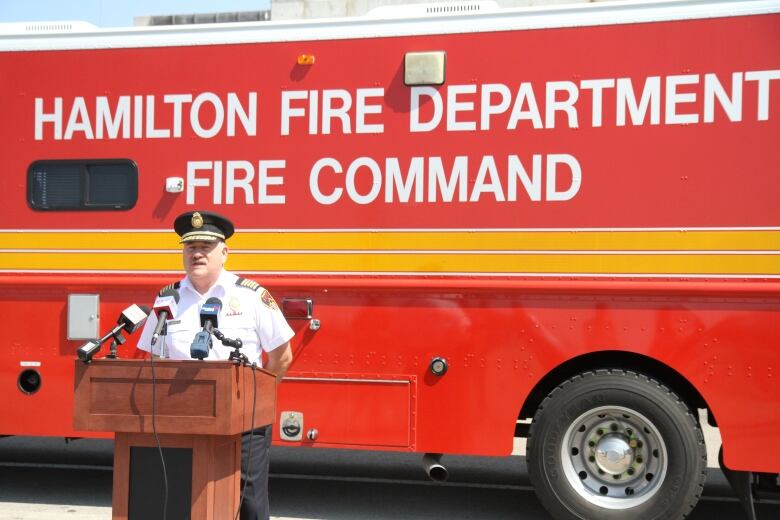'I'm getting there': Firefighter hurt during rope rescue says he's nearly ready for work
Charles Madder needed major surgery after his nose was ripped off while rescuing people at Albion Falls

The ledge overlooking Albion Falls was a place Charles Madder had trekked many times before.
As a Hamilton firefighter, he'd done more than two dozen rope rescues over the years, a lot of them at the popular cascading waterfalls. He'd saved injured hikers, and people who had slipped off the trails. He'd even done a rope rescue of someone who'd climbed a crane.
He was so good at it, in fact,that he was a captain. A team lead.
Then just after 10 p.m. on July 31, 2019, "in the blink of an eye," he became a rescuee. He was standing on a ledge, scanning for missing hikers, when the ledge crumbled. He fell 20 feet, hit more rock, then fell another 10 feet and landed face-first in shallow water at the bottom of the waterfalls.
Madder, 40, is still recovering from major head injuries. His nose was ripped off, and surgeons took more than six hours to reconstruct it. His head was split open. His skull was shattered, and he had two brain bleeds.But he's well enough and enthusiastic enough to be a patient ambassador for this year's Hamilton General HospitalStrides For The Generalfundraiser.

"I'm not 100 per cent of what I was before, but I'm getting there," he said.
"I still have some lingering things. I get fatigued sometimes, unexpectedly." When that happens, he said, the headaches return, and the words he's reading blur.
But "I'm at a point now where I'm almost ready to return to work."
When Madderbecame a Hamilton firefighter in 2007, emergency services was already in his blood. His father-in-law is retired from Toronto Police Service. His dad was a volunteer firefighter for more than 30 years.
Madder first learned the highly technical skill of rope rescues when he was at Station Six at the corner of Barton and Wentworth streets. When the fall happened, he was working at Station 17 in Stoney Creek. He's not sure how many rope rescues he's done, but it's at least "in the mid twenties." A lot of them, he said, have been at Albion Falls.

On July 31, he and his crew answered a call about some lost hikers. They used a key to go through a gate leading to the edge of the cliff. The city, seeing a rash of injuries and deaths at waterfalls in 2016 and 2017,had closed off thatarea, so a spot previouslyworn down by foot traffic was overgrown with brush.
It was dark, and Madder said hekept a safe distance from the edge. But the rock seemed to have eroded from underneath, and the ground crumbled under his feet.
Madder said he passed out at some point during the fall. When he woke again, he was in the water, in the dark, at the bottom of the waterfalls.
The crew hadn't made it to him yet, he said, so he pushed himself onto all fours and crawled toward the embankment.
He knew he had a head injury, he said, but "I had an adrenaline spike. I didn't feel pain anywhere else." The adrenaline wore off as he was being examined, he said, and the pain "sped up fast."

He was in hospital for nine days, he said. His wife Suzanne visited him there, but his two sons, six-year-old Austin and three-year-old Dylan, didn't. He didn't want them to be traumatized by his facial injuries.
Support poured in from the community. The Hamilton Tiger-Cats flashed "Get well soon, Charlie" on the scoreboard. Members of the firefighters union delivered meals and did his yard work. It was so great, he said, that they eventually had to turn away help.
Stan Double, president of theHamiltonProfessional Firefighters Association, said Madder's injury impacted everyone in the tight-knit fire department.
"When one goes down, we all go down," he said. "When Charlie was injured, there was a tremendous amount of fear and anxiety, and we were all elated when we found out he would recover from his injuries."
"Charlie'sa tremendous firefighter, well respected by his peers."
Madder has worked with an occupational therapist, and is a patient with theHamilton Health Sciencesacquired brain injury program. He still has some post-traumatic stress disorder, but the blurred vision and headaches are fading. He hopes to get back to work in the fall.
"I have nothing against the rope calls," he said. "Right now, Ifeel like I would be fine going back into ropes. We're just going to take it as it goes."
Strides for the General
When: Sept. 10 to 19.
Where: Participants will walk in their communities because of COVID-19.
What: The event raises money for priority needs at Hamilton General Hospital, the Regional Rehabilitation Centre and St. Peter's Hospital. Participants register for a five-kilometre walk or run, or a 10-kilometre run. The goal is to raise $150,000.
Registration fee: $20. Participant kits include a face mask, running socks and more.
More info:hamiltonhealth.ca/strides












_(720p).jpg)


 OFFICIAL HD MUSIC VIDEO.jpg)
.jpg)



























































































